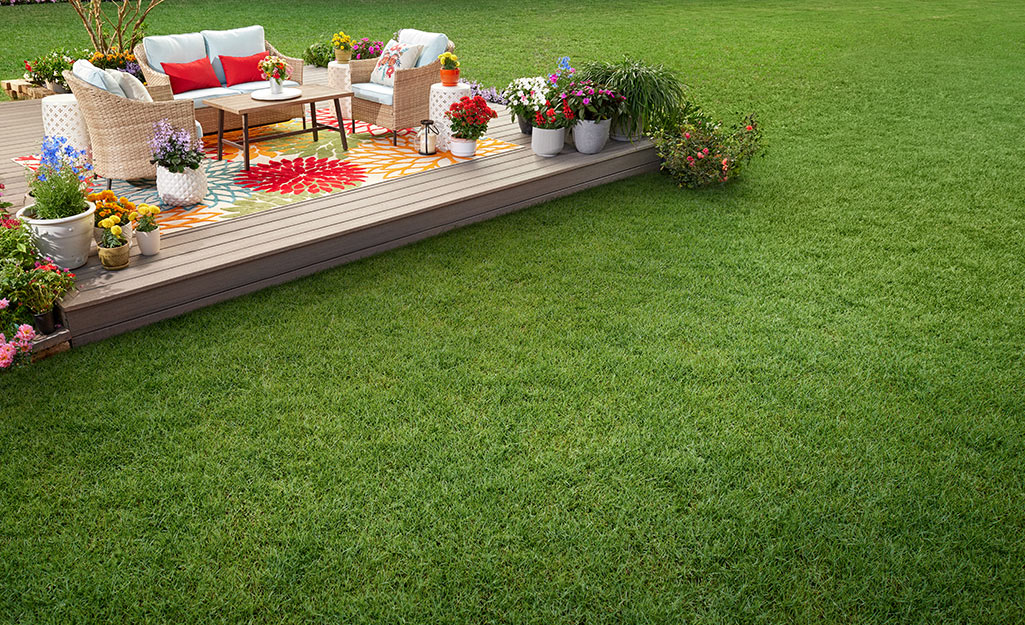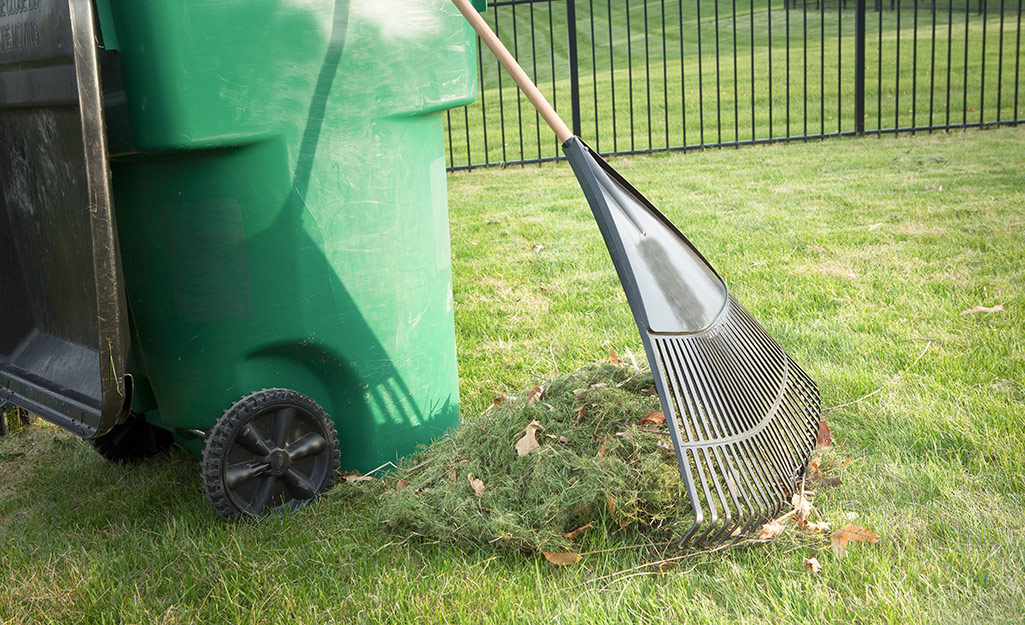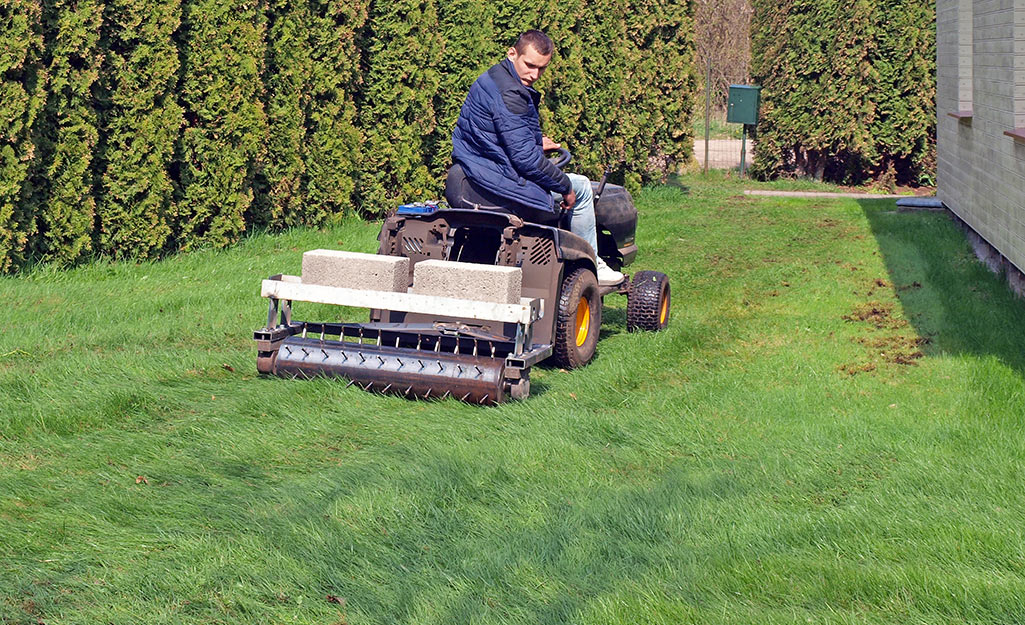Overseeding a Lawn

Last updated September 7, 2023
Growing a healthy lawn often means knowing how and when to overseed. Lawns can show damage from a lack of water, heavy foot traffic and heat.
Renew your landscape by overseeding your lawn. You don't have to break up your lawn or soil when you overseed.
Read on to learn how to overseed your lawn and improve your grass. Plus, find out how to fill in bare spots and add in new and better varieties of grass.
Difficulty:
Intermediate
Duration:
2-4 hours
Table of Contents
How to Overseed a Lawn
Prep and Plan
Mow and Dethatch
Aerate Lawn
Reseeding Lawns with Bare Spots
Overseed and Fertilize
How to Overseed a Lawn

Overseeding a lawn means planting grass seed directly into your existing grass. It helps prevent weeds from taking over your lawn and promotes healthier growth. One of the most important things to consider for overseeding is timing. Additionally, proper overseeding depends on the type of grass that grows best in your climate.
Of course, you can try sprinkling grass seed on your lawn. Simply adding grass seed to your lawn will result in poor seed germination. You will get best results when you follow to steps for overseeding a lawn.
Overseeding a lawn is best done in spring or fall, depending on the type of grass in your yard.
- Kentucky bluegrass, perennial ryegrass and fescue are cool season grasses. Overseeding a lawn in fall is ideal if you’re growing cool season grasses. That's because the soil is still warm enough for seeds to germinate and the cool air helps grass to grow a strong root system. Cool fall weather starts earlier in the North, so it’s recommended to overseed cool season grass by late summer or early fall.
- Bermuda, Centipede, Saint Augustine and Zoysia are warm season grasses. Late spring or early summer is ideal for overseeding warm season grasses, especially in the South. Make sure to water grass seedlings frequently and lightly in spring or early summer. This will help them get established before hot, dry weather sets in.
Prep and Plan

Overseeding a lawn takes planning and preparation. You'll need tools like a mower, a thatch rake, an aerator and spreader. Before you start:
- Figure out the size of your lawn. A measuring wheel can help. Multiply the width and length of your lawn to get the square footage. If you have more than one grassy area, find the square footage for each section and add the totals together.
- Stop fertilizing your lawn for at least a month before overseeding. The fertilizer makes your grass grow faster, which makes it harder for the new seeds to take hold.
- Identify your grass type or the type of grass you want to grow. That way you can manage it appropriately.
- Consider the climate of your growing region, look at the shape of your existing grass blades and feel the texture of the existing grass.
Mow and Dethatch

Thatch is a spongy layer made up of dead grass blades, stems and roots mixing with living plant parts. A thick layer of thatch can lead to disease and insect problems if you don't remove it. It can also keep grass seeds from germinating.
- Mow your lawn so that the grass sits above the soil line. Ideally, the grass blades should be no more than 1 to 1 1/2 inches high. This will let the new grass seed get enough sunlight and make good contact with the soil.
- Use a dethatcher or power rake to dethatch or remove any thatch you find.
- To dethatch, rake your lawn in one direction. Give it another pass in the opposite direction. The tines on the rake will pull up the thatch along the way. Be sure to remove the thatch off the lawn.
Aerate Lawn

Aerating your lawn loosens the soil so air and water can reach the roots. It also combs out your grass and kicks out debris. Aerating your lawn will help grass seed grow faster and better. It's especially important to aerate lawns that are compacted by heavy foot traffic.
To aerate a lawn, move a core aerator across the yard in straight lines. Cover the entire yard. Do a second pass perpendicular to the first one, if needed. The core aerator should pull up plugs of soil instead of just punching holes in the ground. This helps break up the compaction. Leave the plugs on the ground and they'll disintegrate in a couple of weeks.
Reseeding Lawns with Bare Spots

Reseeding lawns can also help with any bare spots in your grass. To reseed your lawn, fill in bare spots with topsoil before you overseed. This improves the quality of the soil and helps the grass grow.
Some bald spots are in areas with water drainage problems. Add a thin layer of sand first and smooth it out with a rake. Sand helps the grass seed germinate faster and develop a good root system.
Overseed and Fertilize

- Spread your grass seeds evenly around the lawn. Use a broadcast spreader, drop spreader or handheld spreader.
- After overseeding, apply a lawn fertilizer that works best for your type of grass. Slow-release fertilizer provides nutrients gradually, for as long as three months in some cases.
- Lightly water your lawn immediately after overseeding.
- For the first several weeks, water your lawn about three to four times a day. This will help the seeds germinate.
- Once the grass is an inch tall, cut back to watering once a day.
Tip: When determining how much grass seed you need, don't guesstimate, calculate. Know exactly how much you need with our grass seed calculator.
Overseeding Maintenance

- Keep mowing the grass to two inches tall for the rest of the season. Always wait until the grass is dry before you mow.
- Fertilize the lawn about six weeks after you sow the seed. Apply a pound of quick-release nitrogen fertilizer for every thousand square feet of lawn space. For example, if your lawn is 5,000 square feet, you would need five pounds of quick-release nitrogen fertilizer for your specific grass type.
- Repeat the feeding in another six weeks or as directed on your product label.
Once you know how to overseed a lawn, you’re well on your way to a better lawn. Overseed your lawn to keep it healthy, repair damage or fill in bare spots. Remember to identify your grass type before you begin. Then mow, dethatch and aerate your lawn. Keep watering the new grass a few times each day for the first several weeks. Wait six weeks before fertilizing.
Need help identifying a tool or material? Use The Home Depot Mobile App to locate products and check inventory. If you need some extra help overseeding your lawn, consider renting an overseeder, power rake or aerator with our overseeder rTool Rental to get your project done. Use once, then bring it back - no maintenance required.



























